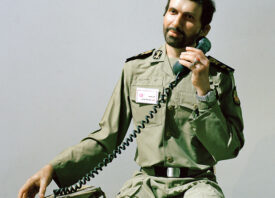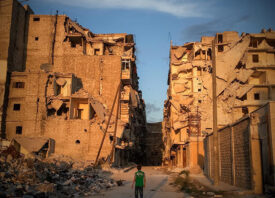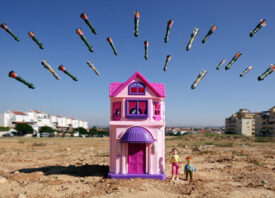Search this site
Inside the Diary of a War Photographer

(Christoph Bangert for The New York Times)


Soldiers of 1st Platoon, Apache Troop, 1st Squadron, 75th Cavalry Regiment, (1-75th CAV, “The Widowmakers”), 2nd Brigade Combat Team of the 101st Ariborne Division are taking part in an operation called “Dragon Strike” in the southern part of Zhari District in Kandahar Province. The aim of the operation is to push Taliban fighters out of the area, which previously had no Afghan Government or Nato presence at all and was completely controlled by the Taliban.
Soldiers demolished or blew up every single uninhabited building they came across and also built a so called ‘combat road’ across fields and through villages with the help of an armored bulldozer.
Zhari District, just west of Kandahar City, is the true heartland of the Taliban. It was here, in a small village called Sangisar, the home of Mullah Omar, where the Taliban were founded in 1994 and from where the movement started its bloody campaign against warlords who had turned Afghanistan into a country fractured into local thiefdoms and plagued by civil war and corruption.
Along with the bordering Arghandab and Panjwai Districts, Zhari District remains the most fought over terrain in Afghanistan. © Christoph Bangert
“I believe I’m now the longest-running Iraq/Afghanistan NYT-rotation photographer,” Christoph Bangert wrote in his journal on June 24th, 2013, on a plane to Istanbul. “Everybody else stopped covering wars or is no longer working for the paper. Others got injured or quit photography. Anyway, it makes me feel kind of old. And slightly suspicious. Why I am the last one standing?”
It might be because he took long breaks. Maybe it’s because he’s diplomatic and that suits the job well, or maybe it’s just “plain stupidity.” Whatever it was, he was flying again, headed to Kabul, on assignment from The New York Times. He’d just said goodbye to his wife, Chiho, and their two daughters, Anna and Lilli. He brought with him a Fujifilm instax mini, intending to illustrate his journal with pictures.
That journal, the instant photographs, and some of the pictures he’d make while covering the war in Afghanistan from 2010 to 2013, are now bound together as part of Rumors of War, a notebook-sized photobook published by Kehrer Verlag. Though it stands alone, the book is one of a series that began with War Porn, the book where Bangert published the photographs deemed too horrific to be published elsewhere, understanding that that needed to be seen. It follows hello camel, a testament to the strange and terrible absurdity of conflict.
In some ways, Rumors of War is the most unusual of these three uncommon books, providing a firsthand account of daily life on assignment. It’s also the most personal, featuring photographs of Bangert’s hotel rooms, meals, belongings, colleagues, the people he meets, and, perhaps most importantly, his family. The photographer himself appears throughout: at the office, at the hotel, at 2:30 AM after trying to sleep at the airport, at home at last.
The text is handwritten and, at times, difficult to read, which feels important. It forces you to slow down and spend time with the words, just as he spent time writing them out. A word or two might be lost here and there; sometimes, it takes two or three passes to make out the details.
While in Afghanistan, Bangert sees a rock concert. At one point, there’s a watermelon eating contest. Then he goes to photograph Hamid Karzai, then the President of Afghanistan, on assignment from The NYT Magazine. It’s so dark on his first visit that he has to crank his ISO to 3200. The book is about the details that happen in-between the moments that make the news–the everyday encounters, conversations, commutes, and meals that define the photographer’s day-to-day.
But more than that, it’s about war, what drives someone to cover it, and the marks it leaves. While Bangert was away, his family and friends, in his own words, went through hell. When he got home, he tried to find peace, even amid PTSD and nightmares. He founded the Fotobus Society, a non-profit traveling photography school. He misses the sense of purpose that came with being a war photographer, but he’s coping, and he’s helping others.
Rumors of War closes the chapter on Bangert’s years as a war photographer. The book is simultanouesly a diary, a farewell, and a historical document. It’s also a promise. “It will be a struggle to figure out peace,” the photojournalist writes. “There will be setbacks. But one thing I’m sure about: I will never go to war again.”
Order your copy of Rumors of War by Christoph Bangert here.

Soldiers of 1st Platoon, Apache Troop, 1st Squadron, 75th Cavalry Regiment, (1-75th CAV, “The Widowmakers”), 2nd Brigade Combat Team of the 101st Ariborne Division are taking part in an operation called “Dragon Strike” in the southern part of Zhari District in Kandahar Province. The aim of the operation is to push Taliban fighters out of the area, which previously had no Afghan Government or Nato presence at all and was completely controlled by the Taliban. © Christoph Bangert







All images courtesy Kehrer Verlag



